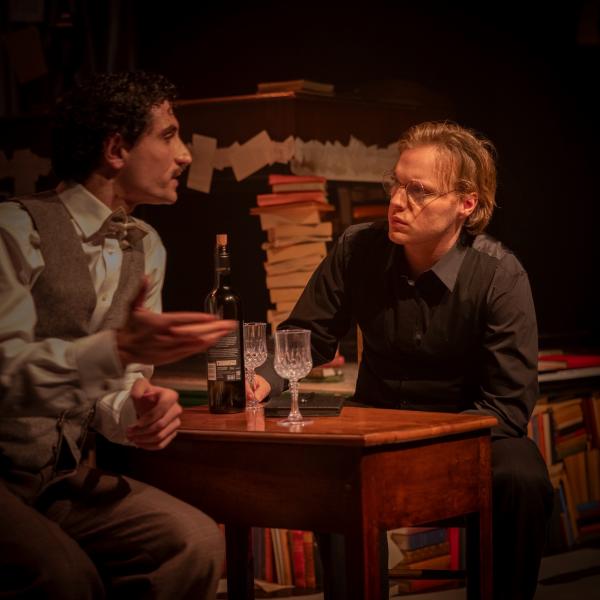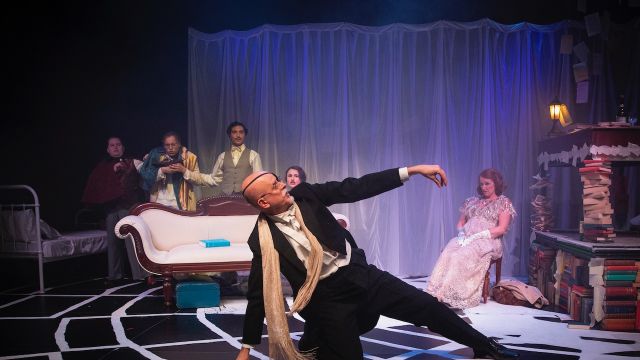Samuel Beckett & The Rainbow Girl
There are complex and intriguing elements underlying Samuel Beckett & The Rainbow Girl. The poster for the show tells us that it is a story of ‘Genius, Madness, Sex & Violence in 1920s Paris’. ‘Genius’ is James Joyce, struggling with what will be Finnegan’s Wake, and the young incipient genius Samuel Beckett struggling with what sort of writer he wants to be. ‘Madness’ here is Joyce’s daughter Lucia who was committed to an asylum in 1935 and died there in 1988. She is a talented but frustrated dancer, considering herself an ‘artiste’ in her own right, and the unrequited lover of Beckett – so the ‘sex’ here is what is pursued, but doesn’t happen. ‘Violence’ is the turmoil of emotions and the incarceration of Lucia in a mental hospital – and an incident in which Beckett is knifed in a Paris street. Supporting cast in this twisted tale are Nora Joyce (née Barnacle) (Carissa McPherson)Lucia’s helpless mother (in this iteration anyway), Lucia’s largely useless brother Giorgio (Daniel Cook) whose role is rather vague, and family friend and Beckett’s confidante Tomasso Grigio (Paulo Bartolomei.)
There are some great performances here. Tref Gare gives us a James Joyce as a preening, extravagant, self-styled ‘genius’. Terrified that he won’t follow up the success of Ulysses, he’s selfish and self-absorbed. When he adopts a heroic pose, looking off into the middle distance, it’s funny and an implicit criticism of Joyce and his conceit, the man who wrote two books difficult if not impossible for ‘ordinary’ people to read. Joyce loves his daughter, but on his terms. It’s ironic that Joyce, the literary iconoclast, author of a book banned for its sexual content, frets at the respectability of his daughter’s art, which at the same time, he somehow can’t take seriously…

As Lucia, the daughter, Mary Agnes O’Loughlin shows enormous talent with what the text gives her: it’s a strangely underwritten part in which she manages to be briefly touching. O’Loughlin is also a fine dancer, which gives substance to her character’s claims and ambitions.
Too bad that both – and the rest of the cast - are sometimes defeated by the Irish accents so as to become incomprehensible – at least to me, but obviously not to director Carl Whiteside. Perhaps a dialogue coach might’ve helped.
Nevertheless, with this potentially rich mix, playwright (also producer) Steve Carey makes some puzzling choices. The crux of it, as the title suggests, is the love affair that doesn’t happen between Lucia and Beckett – but as the play proceeds that element seems to lack substance. Each time Beckett visits the Joyce household, Lucia throws herself at him – literally. Are we meant to believe his rejection is what makes her crazy? Here she’s already crazy, jumping around like a fly in a bottle, but it’s also unclear why Beckett rejects her. Crazy or not, O’Loughlin is certainly very attractive. Is it because she’s a disturbed or unstable, too demanding and frightening? Is it because Beckett doesn’t want to offend his mentor, Joyce? Or he’s too preoccupied with finding his own style, as he begins to discover he’s at odds with his mentor?

Also puzzling is the depiction of Lucia herself, the ‘Rainbow Girl’ of the title. Is this play her story? Is she the central character? She does provide the framing device: Lucia in the asylum visited by a guilty (?) Beckett, we’re not too sure when. If the intention is tragedy, the text neglects the process that gets her committed by her father. It also softens Nora’s jealousy, verging on hatred, for her daughter.
The text diminishes Lucia, reducing her to a sex-starved but disturbed therefor uninhibited woman who wants to dance but whose dancing seems here to consist of her prancing around in the living room, constrained by her anxious father. Apart from her rejection by Beckett the historical record shows that Lucia was more complicated – and interesting. She had numerous affairs later and was a well-known exponent of ‘modern dance’ who danced on stages all over Europe, but who did suffer resentfully from living in her father’s shadow – until she became uncontrollable (‘difficult’?), and, after employing a raft of expensive therapists, he ‘had’ to put her away.
Instead, Carey’s text diverts to Joyce’s and Beckett’s artistic problems and inserts the incident of Beckett’s stabbing (which in terms of the overall story is neither here nor there). Beckett in hospital allows Paulo Bartolomei, doubling as a disabled doctor (called Godot!) to do a comic turn, and getting a lot of laughs, but completely stealing the scene from Joyce and Nora who’ve come to see Beckett. Did someone say, ‘Wouldn’t it be funny if Dr Godot had a funny walk?’ What did she do or think that made Joyce’s grandson – and maybe Lucia’s brother Giorgio – purloin and burn all her papers after her death?

Am I asking for a different play? I don’t think so, but the title – The Rainbow Girl – is misleading. What is clear is that Steve Carey has done a great deal of research and then made his choices from it. But in trying to cover too much, his play seems unfocussed and that therefore reduces its emotional impact. Even if the play were an ensemble piece, Lucia lacks crucial development. I know comparisons are odious, but a simple little two-hander chamber piece, Solas, by Dianne Stubbings, performed at La Mama in 2022, gave Lucia her due, and made us care for her. As the program notes indicate, there is since the turn of the century, a certain fascination with Lucia shown by biographies and another play, Calico. Unfortunately, Carey and director Carl Whiteside place their focus elsewhere.
Michael Brindley
Photography by Jody Jane Stitt.
Subscribe to our E-Newsletter, buy our latest print edition or find a Performing Arts book at Book Nook.

